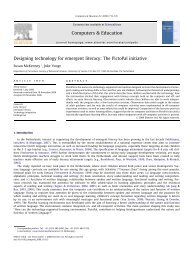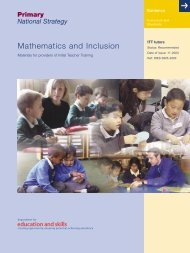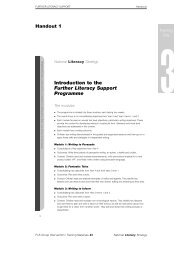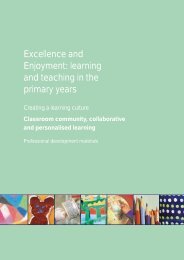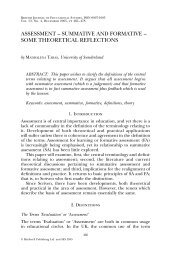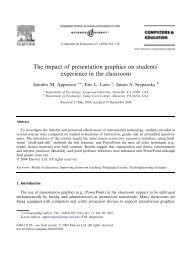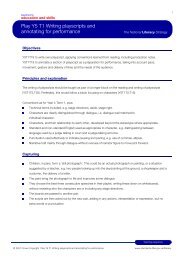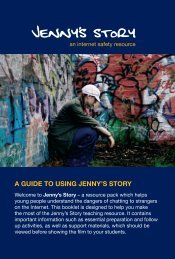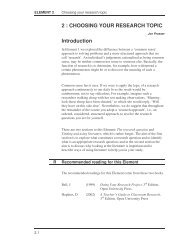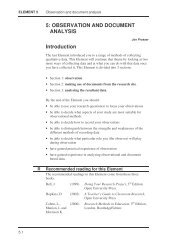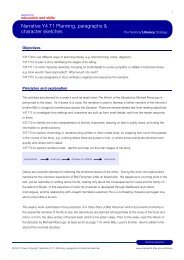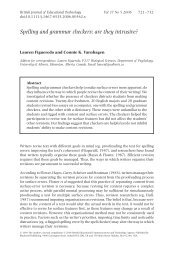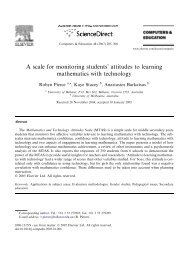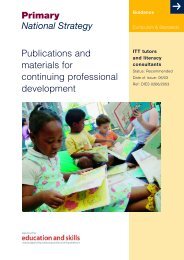U C E T - PGCE
U C E T - PGCE
U C E T - PGCE
- No tags were found...
Create successful ePaper yourself
Turn your PDF publications into a flip-book with our unique Google optimized e-Paper software.
U C E TUniversities Council for the Education of Teachers A Registered Charity (No 275082)DRAFTEVERY CHILD MATTERS AND TEACHER EDUCATION: TOWARDS A UCET POSITION PAPERGordon Kirk and Pat BroadheadIntroduction1. As befits a representative body, UCET has a tradition of publicly affirming its stance on issuesthrough the generation and dissemination of position papers. Such papers perform several importantfunctions: they articulate policy; they assert the values which UCET espouses; they provide the basisfor discussion and negotiation with government and other agencies; they honour UCET’s obligationto contribute to the public debate on education and teacher education; they draw on a massiverepository of expertise and experience to enhance quality and standards in teaching; and they informdiscussions within institutions about the development of their provision, offering teacher educators ameasured statement in the light of which they can evaluate their own work.2. At its June, 2006, meeting the Executive Committee commissioned UCET’s Academic Secretary,and the member of the Executive Committee who had been specially co-opted for her expertise andstanding in early years education, to develop a Position Paper, following consultation throughout theUCET community and beyond, on ‘the implications, from the perspective of the higher educationbasedteacher education sector, of the ECM agenda’. The original terms of the commission indicatedthat the focus of the paper should be on the early years. To avoid the danger that a paper with astrong early years focus might reinforce the misconception that ECM relates to the early years only,rather than presaging a transformation of educational provision at all levels, it was agreed that thepaper should dwell on the impact of ECM on teacher education in general, while devoting specificattention to the major developments that are taking place in regard to the early years. It wasstipulated that the paper should be completed in time to be launched at the UCET conference inmid-November, 2006.Structure of Paper3. The paper is structured according to the following sequence:• evidential base and fieldwork• policy drivers of ECM• basic principles of ECM• integration of services• teaching, inter-professionalism and ‘personalisation’• the revision of teacher education• ECM and early years provision• staff development in higher education institutions4. That structure moves from an analysis of the genesis of ECM and its fundamental purposes to aconsideration of the role of the teacher in the context of more integrated service provision forchildren and young people. That discussion provides the basis for an elaboration of the modificationsrequired if teachers and related professionals are to be fully prepared for, and supported in meeting,the challenges which ECM heralds for all who work with children and young people.Evidential Base and Fieldwork5. To ensure that the Position Paper was well grounded, formal interviews were held with 15individuals or groups, eight of whom were associated with the ECM initiative at national level, being1
children living in poverty, of ill-health, of mental illness, of offending and re-offending, of teenagepregnancy, of drug-abuse, of non-involvement in education and training post-16, and of childrenwho are the victims of crime. They pointed to the growing gap in achievement between youngpeople from different socio-economic backgrounds, to significant under-privilege and disadvantage,and to social exclusion and social malaise on an unacceptable scale. And they documented thecumulative effects of poverty, of personal breakdown, of living in stressed and malfunctioningfamilies, and of neighbourhoods in which aspirations and opportunities were crushed by the coexistenceof multiple adversities.9. The consensus of these official documents was that existing interventions were provinginadequate. In the words of the Green Paper, all of us stood ‘to share the benefits of an economyand society with less educational failure, higher skills, less crime, and better health’. Besides, failureto make proper provision to combat exclusion increased the likelihood that subsequent forms ofsocial and personal breakdown would make even heavier demands on the public purse. Soundinvestment in tackling the roots of exclusion was not only a way of creating a more just and cohesivesociety, one in which life chances were less unequal, but also represented a wiser use of communityresources.10. What, then, was required? Firstly, there was a need for the community to endorse the needs ofchildren and young people. Secondly, it was essential to structure services in a way that renderedthem more responsive to these needs. That meant that services should be organised morecoherently, with professionals and agencies working collaboratively to serve children rather than toprotect professional boundaries. Thirdly, the emphasis should lie in early intervention and preventionrather than in belated responses to crises. By championing such an agenda ECM sought to respondto the problems raised by the case of Victoria Climbie, but also extended the arena of reform to reenergisea number of other national initiatives and to integrate them into a coherent strategy forservice improvement.11. There were four other aspects of national educational policy with which ECM articulated. Firstly,for some thirty years prior to the publication of the Green Paper there had been sustained pressurefrom the early years sector for integrated services for children. That pressure led to the establishmentof Early Years Development and Childcare Partnerships, which marked the beginnings of localauthority integrated service provision for children and their families. ECM provided an impetus tosuch restructuring.12. Secondly, there was the political imperative to raise standards of achievement in schools. Thatimperative, manifested in the systematic testing of pupils’ achievements at different ages and thecompilation of league tables based on results in national examinations, rested on the assumptionthat the raising of standards was the antidote to many of the conditions that imperilled the lifechances of young people. For their part, critics questioned whether the relentlessness of the testingregime so exalted cognitive development that it devalued other equally important educationalobjectives, and represented a highly restricted view of human flourishing. ECM of course retains thecommitment to nurture the achievements of learners but it duly recognises that learners have otherneeds. The significant shift in the political discourse is from the promotion of learners’ achievementto the cultivation of learners’ achievement and wellbeing, a shift that is encapsulated in theneologism, edu-care.13. A third and related strand of policy concerns the extended school. The notion of the school asthe focal point for a range of services for children, families and communities was first implemented ina major way in the UK in the New Community School initiative in Scotland in 1999. Drawing on thetradition of ‘full-service’ schooling in the USA, these New Community Schools were championed bythe Secretary of State for Scotland as agencies for addressing children’s needs ‘in the round’,through an ‘integrated approach in which expert advice and support is at hand, not at the end of areferral chain to other agencies’. The early research on the 25 DfES pathfinder projects mounted in2002 indicated that there was a lack of consensus on what constituted an extended school, or onhow student and community needs were to be identified and addressed, other than by reference toa deficit model. The ECM initiative is interpretable as a way mainstreaming such schools, asforegrounding them as primary vehicles for the realisation of wider social and community aspirations,and of confirming their standing as integral features of a coherent national strategy for children andyoung people.3
14. The fourth of these policy precursors is workforce re-modelling. In 2003, that initiative sought toaddress teacher workload by freeing teachers from non-teaching duties and enabling them toconcentrate on their core professional responsibility of promoting learning by significantly extendingthe range of support staff roles in schools. That change may have been perceived as a way ofreleasing teachers from their wider professional responsibilities. ECM may be seen as a corrective tothat perception, by affirming that every teacher, regardless of specialism, has a responsibility tocontribute to the general wellbeing of learners as well as to their academic achievement. In addition,ECM reinforced another outcome of re-modelling, by repudiating the notion of teachers as solitaryoperators, by strongly endorsing the ethic of professional team-working with HLTAs, TAs and others,and by portraying schools as appropriate contexts for inter-professional collaboration.15. While, then, the death of Victoria Climbie may have been the spark that lit the ECM fuse, thismajor initiative developed its significant momentum at least partly because it exploited the politicalwill and public appetite for radical change to re-energise several antecedent strands of social andeducational policy that were already in process of implementation, and wove them into a single,comprehensive and coherent strategy.Basic Principles of ECM16. One of the striking features of ECM and similar policy initiatives elsewhere in the UK is that theyare unashamedly needs-centred: across the UK its fundamental purpose is to meet the needs ofchildren and young people. These needs have been publicly endorsed as ‘outcomes’ and may be saidto represent an entitlement for all children and young people. They are expressed in these terms:Northern Ireland: being healthy; enjoying, learning and achieving; living in safety and with stability;experiencing economic and environmental wellbeing; contributing positively to community andsociety; living in a society which respects their rights.Scotland: achieving; being healthy; being included; being respected and responsible; being nurtured;being active; being safe.England: being healthy; staying safe; enjoying and achieving; making a positive contribution;economic wellbeing.Wales declared a commitment in to ‘tackle disadvantage’; ‘to promote equality of opportunity’; toovercome ‘the barriers to learning’; and to reduce ‘inequality of achievement’. To that end, the aimwas to give ‘every child a flying start’ and to ‘offer a curriculum in harmony with each child’sparticular needs and interests’.17. These are outcomes which all of those working with children and young people must becommitted to meeting and improving. They underpin the whole superstructure of services forchildren and young people; they are intended to give point to every professional endeavour; and theyare to govern every engagement which the community arranges to support the wellbeing of childrenand to nurture their educational progress.18. As listed above, the outcomes are perhaps too general to act as targets for educational or socialaction. In response to that difficulty, in England the five needs have been expressed as 25 ‘specificaims’, from which there has been derived an ‘outcomes framework’ to measure the extent to whichchildren’s needs are being met. Thus ‘being healthy’ is expressed in more precise terms as• physically healthy• mentally and emotionally health• sexually healthy• healthy lifestyles• choose not to take illegal drugs19. It would be surprising, were the lists for the other parts of the UK to be expressed in morespecific terms, if any significant differences would emerge.20. It is further maintained that these needs are inter-dependent. In the words of Every ChildMatters: Change for Children,The outcomes are inter-dependent. They show the relationship between educationalachievement and wellbeing. Children and young people learn and thrive when they are healthy,4
safeguarded from harm and engaged. The evidence shows clearly that educational achievementis the most important way to improve outcomes for poor children and break cycles ofdeprivation.21. The corresponding Northern Ireland document refers to the ‘interconnectedness of children’slives’ and to the ‘links between good health and good education outcomes’ and to ‘the linksbetween poverty and poor health outcomes’.22. These needs statements are now formally embedded, in England through the Children Act of2004, and now represent the corner-stone of services for children and young people. They have beenincorporated into the Standards for Classroom Teachers and form part of the framework of OFSTEDinspections of schools, children’s centres and local authority provision for children, as well as ofinspection regimes in other parts of the UK. The watchwords for the reformed services have becomeresponsiveness, prevention, early intervention, protection, support for families, all to engender andbuild up through policy and practice that ‘resilience’ in children and young people, in their families,and in their neighbourhoods that is ‘the key to wellbeing and overcoming the effects ofdisadvantage’. (Edwards, 2005). It is now accepted that no single agency can achieve any of theoutcomes for children acting in isolation. Reformed provision must be based on strong universalservices with readily accessed and targeted specialist support. It is widely acknowledged that thenecessary quality of provision rests pre-eminently on two essential conditions: firstly, services need tobe reconfigured round the child and the family, in one place, to permit professionals to work in closecollaboration in multi-disciplinary teams; and, secondly, the service must be staffed by a wellmotivatedand professionally equipped workforce. How are these conditions to be met?Integration of Services23. Across the UK it is accepted that the traditional configuration of local education authority andother provision for children and young people was no longer fit for purpose and needed to bereplaced by a unified structure under the leadership of a Director of Children’s Services. In England,this change was heralded in the Children Act of 2004, which placed a duty on local authorities tofoster cooperation between agencies, including voluntary bodies, to improve children’s wellbeing,and obliged other key agencies to safeguard and promote the wellbeing of children. The preferredmodel for effecting change is the Children’s Trust, which is a partnership of a range of all the servicesimpinging on children, and which exercises strategic oversight of the development of children’sservices and mobilises resources and support to secure the improvement of outcomes for children.24. It is an expectation that that integration of governance will be reflected in the integration offront-line services. To that end, there is a commitment to have in place by 2010 a national networkof Children’s Centres and extended schools, or ‘community focussed schools’ as they are known inWales.25. The commitment to extended schools was reinforced by the findings of the independentevaluation of full-service extended schools (September 2006), which concluded that ‘extendedservices can help individuals and families re-engage with learning’ and can exert ‘a significant impacton their life chances’, and by the OFSTED conclusion that, where schools were providing access toextended activities, children, young people and families benefited from enhanced self-confidence,improved relationships, raised aspirations and better attitudes to learning’. The ‘core offer’ ofextended schools will be:• high-quality wraparound care…available 8am-6pm all year round• a varied menu of activities, such as homework clubs and study support, sport, music tuition,dance and drama, arts and crafts, special interest clubs such as chess and first-aid courses• parenting support including information sessions for parents at key transition points and familylearning sessions to allow children to learn with their parents• swift and easy referral to a wide range of specialist support services such as speech therapy, childand adolescent mental health services, family support services, intensive behaviour support andsexual health services• wider community access to ICT, sport and arts facilities, including adult learning26. Schools based on such provision are thought to confer significant benefits: to enrich learning; toextend the exposure of young people to influences that are educative; to engage parents and carersmore fully in the education of children; and to facilitate multi-agency working, co-locating those who5
are in a position to offer different forms of support and fostering closer and more opencommunication between them. That quality of service represents a significant improvement over thekind of fragmentation of provision that had become all too familiar.27. These multi-purpose extended schools will be supplemented by the measures recently intimatedunder the Youth Matters initiative: to engage young people in shaping local services; to require localauthorities to ensure that young people have access to a wide range of purposeful activities; to fundyoung people directly to mount local initiatives and to take advantage of existing facilities that accordwith their needs and wishes; to encourage young people to undertake volunteering activities that areformally recognised; to establish peer mentoring schemes in secondary schools; to enable youngpeople to enjoy a variety of forms of access to information, advice and guidance that meet nationalquality standards; and to offer targeted support for those with additional needs. All of thesemeasures will fall under the aegis of local Children’s Trusts and therefore form part of the integratedprovision these trusts are expected to provide.Infrastructure of Collaboration28. These structural changes by themselves will not create an integrated service: they need to beunderpinned by mechanisms and procedures that facilitate communication, promote informationsharing, establish a common understanding of children’s needs, and serve to foster a culture of interprofessionaland multi-agency collaboration. To these ends, a battery of measures has beenintroduced, the most significant of which are as follows:The Lead ProfessionalWhere a child is known to more than one specialist agency a designated professional will carryresponsibility for ensuring that a coherent set of services will be provided and for acting as a singlepoint of contact.Common Assessment Framework (CAF)To reduce the unnecessary duplication of assessments and to help to embed a sharedprofessional approach across services, the CAF systematically records in a standard format and innon-technical language, and based on discussions with those involved, the characteristics of thechild, parents and carers, and the neighbourhood environment, the identified strengths and needsof the child, the forms of support provided, and a report on the effectiveness of that support.Information Sharing IndexThis electronic tool will hold basic information on every child, permitting authorised practitioners witha concern about a child to determine whether an assessment has been made or to indicate that theyhave information on a child they wish to share with others who may have been working with thechild.Common Core of Skills and KnowledgeThis statement, which has been developed in consultation with a wide range of professional andother bodies, identifies the core skills and knowledge that should feature in the professionalpreparation of all those working with children and young people. The skills and knowledge relate toCommunication and Engagement, Child and Young Person Development, Safeguarding andPromoting the Welfare of the Child, Supporting Transitions, and Sharing Information. These havebeen subsumed within the revised Standards for Classroom Teachers.Integrated Qualifications FrameworkThe aim is to devise a structure of interlocking awards and transferable units of study that will createcareer pathways and facilitate changes of professional direction for all those working with childrenand young people.Joint statement of inter-professional valuesDeveloped by the GTCE, the GSCC and the Nursing and Midwifery Council, in response to EveryChild Matters, and still in draft form, this statement seeks to identify a set of shared values to whichall those engaged in inter-professional work might subscribe and which might underpin all theengagements of practitioners with children and young people.6
29. These various initiatives are intended to reinforce the ethic of inter-professional working that issuch a prominent requirement of ECM. While they are at different stages of development orimplementation, when fully in operation they will help to establish that professional community ofpractice upon which the success of the ECM initiative ultimately depends. These will all beinescapable realities of the new context of teaching.30. Tomorrow’s teachers will therefore inhabit and expect to flourish in a very different professionalworld. They will find themselves in schools in which the proportion of non-teaching staff hasmarkedly increased; they will be professionally accountable for their contribution to improving theoutcomes for children, in terms of their basic needs; they will require to display a deeper sensitivityand responsiveness to the wellbeing of learners; they will work in schools - if indeed that termremains in use – which are designed to address a wider range of professional concerns than theschools of yesteryear, and which, far from being insulated from their communities, will becomegateways to a network of dispersed learning opportunities, and will draw on wider sources ofexpertise to support learning; they will have a stronger involvement with parents and othercommunity agencies than in the past; they will be members of teams, in some cases in leadershiproles, in others as partners, in addressing shared professional problems; and they will be expectedto engage more frequently in discussions with others from different walks of professional life. Theeffect of all of these changes will be to reinforce the teachers’ fundamental and distinctiveresponsibility for exercising leadership in teaching and learning and maximising learningopportunities.Teaching, Inter-professionalism and Personalisation31. There are, however, two areas in which there appears to be a degree of uncertainty. These relateto the impact on teaching of two ECM themes which feature prominently in the officialdocumentation: inter-professionalism and personalisation.32. The drive in the ECM agenda for inter-professional collaboration, for multi-agency working, forthe flexible deployment of teams reflecting a variety of expertise, has generated an expectation – andin some quarters a fear – that the teacher’s specialist contribution to the educational progress oflearners will require to change. While on the one hand it is maintained that much of the multiagencywork will be undertaken by non-teaching members of the school staff, it is clear that theteacher will require to engage with those other professionals whose work impinges directly on theclassroom, notably the HLTA and the teaching assistant. However, they will also require to be awareof the roles and functions of other members of the school or centre staff and be able to engage withthem on matters that may affect the learning of individual pupils. Besides, one of the commoninterpretations of personalisation is likely to have significant implications for the teacher. On thatview, there is expected to be a loosening up of our educational arrangements, the discarding ofuniform and monolithic provision, the growth of flexibility, and the multiplication of opportunities forchoice – of type of school (Trust School, Academy, or Specialist School), of educational setting(school, FE college or workplace), of learning pathway (as in the 14-19 package of reforms), and ofwhen education should occur in the lifespan (as in the ethos of lifelong learning) – all in the interestsof enabling learners to navigate their way through the system to find opportunities for learning thatare attuned to their personal needs and aspirations. While it has been claimed that these variants ofschooling, with their differing funding regimes and modes of operation and governance, may wellconfer advantages on some pupils and therefore create more inequalities, the increased diversity ofprovision is likely to require teachers to exercise greater professional discretion, to be able to operateover a broader professional base, and to engage with a wider diversity of learners, similar perhaps towhat is currently expected of those who teach in the Learning and Skills Sector.33. There are other interpretations of personalisation. When first invoked by David Miliband in 2004,the term was differentiated from the discredited notion of individualised learning and theirresponsibility of leaving pupils to their own devices: it meant ‘shaping teaching around the waydifferent youngsters learn … taking care to nurture the unique talents of every pupil’. A DfES paperadded a gloss to the effect that, since ‘every child comes to the classroom with a differentknowledge base and skill set, as well as varying aptitudes and aspirations’, there was a need for theadoption of ‘diverse teaching strategies’. Such a rendering of personalisation will be perfectly familiarto teachers and would be a welcome retreat from the heavily interventionist and centralist directionof education that has characterised the last two decades. It is an invitation to assume ownership of7
the teaching and learning process, to be suspicious of one-size-fits-all prescriptions, and to reject amodel of the learning process in which a uniform curricular diet is rigidly dispensed to all. Itchallenges teachers’ pedagogical resourcefulness, demanding of them the capacity to draw on anextensive repertoire of strategies to promote learning.34. A third interpretation of personalisation, associated with Charles Leadbeater, the prominentgovernment advisor, presents a more serious challenge. The central assumption of ‘personalisationthrough participation’ is that users should have a much stronger and direct role in designing,planning and delivering services. In the educational context, such a change would empower learnersto shape what and where they learned, to determine, with help, their own targets and learningplans, how they learned and how that learning might be assessed. The teacher’s role would be ‘tohelp unlock the learners’ needs, preferences and aspirations’; they would become ‘advisors,advocates, solutions assemblers, brokers’, their role being ‘ not to provide solutions directly but tohelp clients find the best way to solve their problems themselves’.35. These various interpretations of inter-professionalism and personalisation, with their references tothe ‘blurring’ of professional boundaries, or the ‘fusion’ of specialisms, threaten received notions ofprofessional identity, subject allegiance, and the authority of the teacher. They create ambivalencewith regard to the nature of the specialist contribution teachers have to make to the ECM agenda.Are teachers to be regarded primarily as learning coordinators, as generalists with responsibility forcultivating such generic capabilities as learning how to learn, problem-solving and critical thinking? Inthat event, what is to become of the teachers’ specialist subject expertise? If indeed subject teachingexpertise is to have reduced importance, will such a change of emphasis weaken the ECM drive tocombat poverty and disadvantage by raising levels of achievement? Finally, how is that supposedretreat from subject specialism to be reconciled with a government policy which appears to favour astrengthening of the role of subject teaching and of subject specialists, for example through involvingthe subject associations in the revitalisation of the curriculum?36. The reconciliation of these tensions rests on a reaffirmation and reinterpretation of specialistsubject teaching. There are those who look upon subject teaching as the transmission of slabs ofcontent for no worthier purpose than examination success, and the subject specialist, operatingwithin a highly restricted pedagogical range, as having no loftier ambition than to crowd pupils’heads with facts. Of course, such characterisations represent an absurd caricature of subjectteaching. Properly conceived, however they are configured and inter-related, however theydifferentiate and coalesce over time, subjects constitute the available ways we have of exploring andinterpreting the world of subjective experience, of analysing the social environment and of makingsense of the natural world. They are communities of debate and argumentation, of exploration andcriticism, of conjecture and refutation; they are pursuits in which knowledge, in due recognition of itsprovisionality, is open to continuous reconstruction. As such, subjects are educational resources ofremarkable power, offering unlimited scope for realising an enormous range of educationalpurposes, for enquiry and reflection, for hypothesising and the interrogation of evidence, foradjudicating between the valuable and the meretricious; for the use of the imagination andcreativity; for the examination of human motive and the improvability of the social condition; forcoming to terms with the responsibilities of citizenship; for promoting personal, social andenvironmental competence; and much else besides. Nor are these purposes restricted to what iscognitive or cerebral: subjects nurture the sense of achievement, the growth of self-confidence andself-esteem, enthusiasm and enjoyment, the self-understanding that comes through challenge, thecapacity to engage and interact with others, and the satisfactions that derive from participation insport, adventure, the arts and forms of service to the community. In all of these ways subjects exert ahumanising, liberating and ultimately transforming impact on learners.37. It would be profligate in the extreme to discard the expertise and commitment of those whothrive in promoting learning of that quality. Fortunately, the ECM official documentation neitherexplicitly nor implicitly requires any such radical and extravagant measure. On the contrary, underECM the educational progress of learners will depend on how resourcefully teachers will be able todraw on their subject knowledge base, and how readily they will jettison the monocular professionalvision that is associated with the blinkered pursuit of the subject, in favour of an approach that fullyexploits all the opportunities for cognitive and affective development, and for the nurturing of skill,insight and judgement that subject teaching at its best involves. However, that pedagogical subjectknowledge, and the capacity to ensure that it issues in accomplished professional performance,8
needs to be generalised so that, within the context of subject teaching and beyond it, the teacher isable to induce the disposition to learn, to relate the activities of the classroom to the social realities ofthe pupils’ experience, to structure learning opportunities appropriately, to remove the obstacles thatcan impede learning, and to energise learners to assume fuller responsibility for, and become moreeffective managers of, their own learning. And in all of that work teachers will be operating from aprofessional base in which subject teaching expertise and proficiency in the facilitation of humanlearning will be mutually reinforcing features, rather than being so antithetical that possession of theone rules out possession of the other.38. On this view, there is no incompatibility between ECM and subject teaching; between teaching asubject and enabling pupils to learn how to learn, or even being a learning coordinator or consultant;between the cultivation of learners’ achievements and fostering their wellbeing; and betweenpersonalisation and the promotion of high standards. These supposed dichotomies are allreconcilable in the kind of extended professionalism that is achieved through a teacher’s specialismrather than by taking a detour round it or submerging it altogether.39. In addition to professing a strength in subject teaching, and the expertise of the specialist inhuman development through learning, teachers in the new context need to encompass within theirprofessional scope the capacities for team-working and collaborative effort. A significant feature ofsuch work will be information sharing. ECM requires that all who engage with children and youngpeople need to become aware of whatever factors in children’s environment may impinge on theirlearning. Teachers therefore must learn to participate in a culture of information sharing: they are ina position, on the basis of their interactions with children, to contribute to a more rounded picture ofa child’s needs and how these might be met. In this sense the relationship between teacher andteaching assistant and HLTA is bound to involve close and continuing professional interchange aboutindividual learners. What is more, teachers will be able to refer pupils with difficulties that cannot beaddressed within the classroom to the many forms of specialist support within the school or readilyaccessed by the school: the mentor, the learning and behaviour specialist, the speech therapist, thefamily liaison worker, and the counsellor, all of whom form a professional network of support forpupils’ progress and wellbeing. The teacher operates within that extended professional network.ECM and Teacher Education40. If that characterisation of teaching in the new context is valid it provides some pointers to thekind of teacher education now required. One response, considered intermittently by Scotland’s GTCover the past two decades, is to institute a new type of teaching qualification, one that is a blend ofsubject study, sociology and psychology, health and counselling studies, and draws on communityeducation and social work approaches. The case for such a change is that, if established interventionsare proving insufficiently effective, there is perhaps a need to attempt a new approach, and tointroduce the teacher who would perhaps be a specialist in lifestyle education and who mightparallel the new Early Years Professional to be discussed below. However, there is no support in theofficial documentation or in the UCET community for such a teacher. The consensus clearly points tothe need to prepare tomorrow’s teachers by making adjustments and refinements to existingapproaches which faithfully reflect the changing role of the teacher.41. The revised standards for classroom teachers already impose certain requirements with regard tothe ECM agenda. Thus, institutions are expected to ensure that those entering the profession arefamiliar with the legislative background within which they will work and the professionalresponsibilities that flow from that legislation with regard to the protection and care of children. Inaddition, they must be able to demonstrate that they can relate their work to achieving the keyoutcomes for children that underpin ECM as well as the six areas of the Common Core of Skills andKnowledge referred to above. Already there is widespread evidence that institutions areincorporating these features into programmes, and one institution visited produced a grid todemonstrate how each of the ECM aims was addressed in all the programme units of study. Beyondthat, there are six changes of emphasis that need to be effected in initial teacher education to takefull account of ECM.42. Firstly, initial programmes of teacher education need to engage students in the analysis of thepolicy context of ECM. It is to trivialise ECM to see it as amounting to nothing more than the morecareful orchestration of services for children and young people. ECM has to be interpreted as anambitious government initiative to improve the education and well-being of all children by9
edoubling our efforts to remove children from the blight of poverty and disadvantage, to arrest andthen reduce the widening gap in achievement between children from different social backgrounds,to render life chances less unequal, and to create a fairer and more cohesive society. Children’sCentres, extended schools and integrated services all derive their meaning and purpose from thatcentral commitment. Becoming a teacher is to acquire a critical appreciation of what it means toshare that commitment.43. Secondly, there is a need to affirm the importance of subject knowledge in teacher education.However they may evolve in response to advances in human understanding or technology, or tofluctuations of intellectual fashion, these domains of knowledge will continue to constitute theprincipal vehicles through which the educational objectives of schools and other settings are realised.However, the approach to subject teaching now required, in line with the emphases that have beenexplicated in the preceding section, calls for a more explicit recognition of the psycho-social andother educational aims that are to be pursued. That is, student teachers need to understand, analyse,apply and, importantly, demonstrate in their interactions with learners, just how their subjectknowledge can be exploited as resources for addressing the needs of children as defined by ECM, forequipping them with the tools of autonomous living, for nurturing their affective as well as theircognitive development, and for cultivating a wide range of social and practical skills. They need tolearn to relate to pupils in such a way that they can make pupils’ personal and social experience thestarting point for their exploration of all that subjects have to offer. Arguably, there can be no morecentral objective of a teacher education programme than to effect that transformation from a personwho has come to know a subject well to a person who can use that knowledge to promoteanother’s development. On this interpretation, student teachers should come to regard the ECMagenda not as an adjunct to their central task but as deeply integral to it.44. Thirdly, beginning teachers need to undergo sustained study of the theoretical perspectives onchild development, on human learning, on the environmental and other obstacles to humanflourishing, on the conditions which maximise learning, and on the manifold ways in which learningis facilitated and managed. There is no doubt that it is helpful to have a system-wide statement ofthe capabilities and other qualities that a teacher should demonstrate before entry to the profession.More than anything, such statements or standards affirm what a teacher should be able to do.However, it can be a weakness of such statements that they so emphasise technical accomplishmentin the efficient management of learning that they do not sufficiently explicate, and therefore maydevalue, the theoretical understandings that should inform teaching. The generalisability of what islearned at the stage of initial teacher education depends on the thoroughness of the studentteacher’s grasp of the knowledge base of teaching. What is sought here is more than a superficialfamiliarisation with the conceptual underpinnings of teaching but rather sufficient analytical powerto maximise the transferability of teaching skills, insights and strategies across a wide range ofcontexts, thus equipping student teachers with the professional versatility that the new contextrequires.45. Fourthly, initial teacher education programmes will need to ensure that their students understandthe inter-professional context into which they will be moving. For example, while it is not expectedthat classroom teachers will be expected to play the role of the lead professional or to carryresponsibility for completing a CAF, they may well engage professionally with those who carry suchresponsibilities or contribute evidence from their own interactions with a pupil that becomes thefocus of inter-professional exchange. They are also entitled to be made aware of the various ways inwhich their membership of an inter-professional culture is to be reinforced, for example through thejoint statement on inter-professional values, and the ethic of information sharing. In that connection,it is vital that beginning teachers come to understand the importance of confidentiality to effectivepractice but acknowledge that it should not suppress professional dialogues that are in the interestsof the child. Furthermore, if engagement with other professionals is to be a feature of theirsubsequent careers there is probably no better time to begin nurturing inter-professionalunderstanding than during the initial teacher education programme. That is now being developedthrough shared learning opportunities, for example in child development, understandingcommunities, child protection, and other cross-professional themes, through paired placementexchanges in which a student teacher and a student social worker take it in turns to mediate for eachother the features of their respective working environments, through the personalisation of thestudent’s own professional learning, and through closer inter-faculty collaboration within highereducation.10
52. These various developments may be characterised as a movement from ‘closed’ to ‘open’systems: from a closed and separate systems of schools to one in which they are open to theinfluences of other agencies; from teaching as a closed and somewhat private engagement betweenthe teacher and a group of learners to a more open one in which the teacher mediates learning in arange of contexts in collaboration with others; from the closed teaching of subjects to the more opennurturing of learners’ educational progress through the exploitation of knowledge to achieve a widerange of psycho-social objectives; and from a teacher education that was professionally isolated andwas preoccupied with technical competence in the classroom to more open and varied forms ofengagement with other professionals.ECM and Early Years Provision53. While the foregoing discussion has been concerned with ECM and teacher education in general,and will therefore also have relevance to teaching in the early years, there have been such significantdevelopments in that phase that they warrant separate consideration. There have been three keydevelopments.54. The first of these is a new curriculum: the Early Years Foundation Stage (EYFS), a single qualityframework for services for children from birth to five. Although currently still at the consultationstage, and due for publication in 2008, this document is integral to the ECM agenda and itssuccessful implementation in the early years. By incorporating the extensive work undertaken inrelation to the period from birth to age three, it extends the early years curriculum from birth to theAugust after the child’s fifth birthday (usually the end of the reception year), bringing a degree ofcontinuity of learning for young children that has generally been welcomed in the sector. However, aview was also expressed to us that the consultation document was ‘designed for use by people whohave not been trained to think about children’s learning’. Understanding learning is undoubtedly thekey to successful curriculum implementation and it is hoped that the final version of this importantcurriculum specification fully recognises the professional and other demands of early years educationas a subject for lifelong learning for all education professionals.55. The early years curriculum (in its broadest sense) and the related literature have always beenconcerned with fostering independent learning in the young child and this emphasis aligns withcurrent policy perspectives on a ‘personalised curriculum’. In these early years, learning through playhas long been acknowledged as central and this renewed emphasis in the EYFS is most welcome.Some, indeed, would have preferred to see it afforded more extensive and explicit recognition. Thepedagogy of play will now need to be substantially addressed for all those intending to work in theearly years sector. Thus, for example, they will need to understand the pedagogical implications ofpromoting child-initiated and teacher-initiated learning opportunities. Of course, it is not beingmaintained that all learning in the early years is play-based, for such learning can incorporateappropriately scaffolded subject knowledge for young learners. There is even a case for play-basedlearning in Year 1 and Year 2, although it is maintained that such an approach is likely to betokenistic as long as SATs exert their impact. If substantial and increased opportunities for play arerecognised as a fundamental entitlement of all early learners, as enshrined in the United NationsConvention on the Rights of the Child, the early years classroom could look substantially differentover the coming years and new teachers will need to understand and implement these changingapproaches to learning.56. The informed and skilful use of observation has long been recognised as an important feature ofthe early years educators’ repertoire, integral to understanding children’s interests and developmentand how these relate to curriculum planning and pedagogy. The EYFS re-affirms its centrality, aftersome years on the margins of initial teacher education. Programmes will need to reflect this renewedemphasis in their structure and help students to understand the relationships between observation,learning, assessment and classroom/setting organisation. Observation and pedagogy are keyelements in the successful co-construction of the early years curriculum, with adults and childrenboth contributing to a process which the EYFS highlights as a mark of effective early years practice.The Common Assessment Framework (CAF) offers a standardised approach to conducting anassessment of a child's additional needs and deciding how those needs should be met. The CommonCore of Skills and Knowledge that underpins CAF can be readily integrated into ITE and relatedprogrammes; within the classroom, the contribution of teachers and associated workers to thisprocess will arise, quite substantially, from close, well structured, observations of children in a range12
of contexts. In particular, observations in the early years will be a key part of the contribution ofteachers and other educators to multi-agency working and inter-professional dialogues for childrenin need. Staff in schools and other settings are well placed to recognise changing circumstances forchildren, and need to understand how to share information of this kind with colleagues and otherprofessionals as part of the early identification of need that is such a key issue in supporting childrenand families within ECM.57. One of the substantive criticisms of the EYFS was the relatively limited emphasis on promotingdiversity or ‘the value of diversity’. If ECM is to manifest itself effectively in educational settings, thenall educational experiences - not just those in the early years - should inherently respect theentitlement of all learners to have their cultural heritage and family/community experiences valuedand reflected within the curriculum and within their playful learning experiences. Most especially inthe early years, effective practice will need to be inclusive of both children and parents/carers, takingfull account of home and community-based experiences. To that end, the construct of ‘partnershipswith parents’ will need to be substantially unpacked and embedded in ITE and related programmes.58. Those who are learning to teach need to know of these trends and of their underpinningrationales in order to engage in these debates as professionals and in order to exercise informedjudgements in their own classes and schools in relation to their role as early years teachers and inconjunction with the other adults with whom they are working.59. The second major development is the emergence of Children’s Centres, which, with extendedschools, will provide a national network of integrated early education and full day care, healthservices and family and parenting support. The government's aspiration is that all children in the20% most disadvantaged wards will have access to Children's Centre services, a rolling programmeof considerable ambition. Current requirements are for 0.5 of a teacher in every establishedChildren’s Centre. Local authorities carry responsibility for implementation, and some have alreadycommitted to a full-time teacher in every centre.60. Children’s Centres have grown out of government policy developed since 1997. Early ExcellenceCentres, (EECs) funded and directed by DfES represented the first national initiative in England tosupport the integration of care and education for children and families. These provided extended daycare for children from birth to age four and a wide range of other family support services, includingadult education. They were intended to provide a ‘one- stop shop’ alongside cutting edge provisionin disadvantaged communities. These EECs were followed by the Sure Start Local Programmes(SSLPs), which fell under the auspices of the Department of Health, and were intended to create arange of support activities which integrated health, education and social services in innovative wayswithin the community. They broke new ground in terms of ‘combined services’ to combat povertyand its detrimental effects on children and families. While the aims of the EECs had beenpredominantly educational, with teachers having a substantial involvement, the aims of SSLPs, wherethe teacher involvement was lower, were predominantly health-related. The intention was tocombine the best of both in the establishment of Children’s Centres. These come under thejurisdiction of local authorities which hold the responsibility for their development in areas ofdisadvantage under the Director of Children’s Services and with local authority funding drawn frombudgets across education, health and social services.61. The Children’s Centre teachers will need:• a commitment to flexible, innovative multi-agency and team working• an understanding of the roles and responsibilities of the other professionals working in the centre• the ability to establish effective and professional relationships with colleagues from differentbackgrounds• a commitment to developing themselves and their colleagues as learners• experience of leading early years provision• strong communication skills, including diplomacy and sensitivity to the needs of others• an ability to translate their own knowledge and understanding into effective practice• a knowledge of child development and children's learning a knowledge of planning, observationbasedassessment and documentation and the importance of sharing this with families62. These requisite attributes demonstrate that a teacher working in a Children’s Centre will need tobe an experienced professional with the capacity to draw on well-developed underpinningknowledge.13
63. It is widely recognised that all teachers will need to understand the changing roles in theprofession relating in particular to inter-professional practice and, more recently, to looked-afterchildren. It is likely that teachers in the early years sector will encounter other professionals at arelatively early stage in their career because of the need for strong home/carer-school links. Whilesenior staff members in schools may have overall responsibility for this aspect of provision,nevertheless new teachers may need to engage with family link workers, social workers, healthvisitors, speech therapists and others in relation to children’s needs. They must therefore understandthe importance of professional dialogues and interaction and learn respect for the contributionsmade by other professional agencies in supporting children and families, key features withinworkforce re-modelling and a core feature of professionalism.64. In the longer term, ECM should involve greater levels of participation in policy and practicedevelopment from local communities. That was a key principle underpinning Sure Start LocalProgrammes and is also manifested in other government initiatives. It also underpins the roll-out ofChildren’s Centres. Whilst it might be very challenging for ITE programmes to incorporate a deepunderstanding of community participation in policy and practice, it is nevertheless their responsibilityto ensure that trainee teachers understand and can act upon the promotion of good home-schoollinks. These links are especially important in relation to young children, who are more susceptible tothe vulnerabilities created by transitions, from home to school, from setting to setting, and fromphase to phase within school. Teachers, therefore, do need to understand the implications for theirown practice and attitudes of building strong relationships with parents.65. The third key development in early years education is the introduction of the Early YearsProfessional (EYP). This initiative – the establishment of a wholly new role – is intended to raise theprofessional level of the childcare workforce as a whole. It was founded on the EPPE study whichshowed that the key factors contributing to the quality of early years experience were ‘well-qualifiedleaders, trained teachers working alongside and supporting less qualified staff and staff with a goodunderstanding of child development and learning’. The EYP is expected ‘to lead practice across theEYFS’. This development certainly complicates the position of the early years teacher.66. The EYP will be recognised as achieving a Level 6 graduate equivalent status. A teacher qualifiesat Level 6 and is a graduate who is also awarded qualified teacher status. A number of organisationsaround the country are providing a range of training routes to EYP status in both part-time and fulltimemodes. Whilst all teachers in England, including those working in the early years, remain underthe jurisdiction of the TDA, the EYP is located within the auspices of the CWDC, which exercisesoverall responsibility for all other members of the children’s workforce, including, for example,playgroup workers, workers in the private sector, childminders, children and family social workers.The CWDC will award the EYP status, thus denying the EYP the professional solidarity and otherbenefits that could follow from membership of the GTCE, despite the fact that TDA and CWDC havebeen asked by the DfES to work in partnership. The CWDC aims to bring an EYP to all Children’sCentres offering early years provision by 2010 and to every full day care setting (including those inthe private, community and voluntary sectors) by 2015, whilst still retaining a commitment toensuring that graduates with QTS are attracted to and retained in the early years workforce.67. Student teachers will need to know of this emerging role, to reflect on the development ofprofessional relationships with EYPs, and to consider the potential value to themselves of gaining thisstatus in addition to their teaching qualification, possibly through the shorter, validation- only, routeto EYPS. However, it remains unclear who would have overall responsibility for curriculumdevelopment should a teacher and an EYP find themselves together in a setting and this uncertaintyhas the potential to create inter-professional tensions without some previous knowledge andconsideration of roles and responsibilities. The complementarities of their knowledge and experiencerequire to be settled officially.68. The EYP may have wider experience of the birth-three curriculum, but teachers may have widerknowledge of learning processes; some, indeed might also claim an equally sound knowledge ofbirth-three if they have followed one of the many early years programmes which cover the earliestyears. They may, for example, have qualified through an early years <strong>PGCE</strong> which followed on from aChildhood Studies/Early Childhood Studies degree programme. If teachers with early years expertiseare to be retained in the early years workforce these and other difficulties need to be swiftly resolved.14
Staff Development in Higher Education Institutions69. The effectiveness of the reform of programmes of initial teacher education and the new forms ofCPD will depend on how well the staff of UCET institutions prepare themselves to address the ECMagenda. There is evidence across the country of HEIs responding positively and energetically to thiskey initiative: regular engagements between HEI staff and senior managers in Children’s Centres andextended schools about the developing professional roles of teachers; discussion of the findings ofresearch into inter-agency activity and multi-professional working and practice to inform programmedevelopment at initial and CPD levels; and the creation of inter-school and inter-faculty teams toconsider multi – professional practices and programmes, in this way eroding some of the institutionalboundaries that helped to isolate teacher education in the past. For example, one of the HEIs visitedhad appointed a new senior member of staff to oversee the institutional response to ECM. One ofthe projects was to mount a level one module, which provided a full briefing on the ECM initiativeand encouraged participants to relate the content of the module to their ongoing professionalactivities. To date, some 200 members of staff have completed the module, which is now beingmade available to staff in other institutions. At a second institution a senior member of staff chairs asteering group, which includes a ‘champion’ for each academic unit, and three cross-institutionworking parties have been established to support a series of modular interdisciplinary learningprogrammes, in conjunction with a neighbouring authority, for staff employed in integratedchildren’s services.70. These examples encapsulate a number of features that typify the response of HEIs across thecountry: inter-faculty and inter-departmental collaboration; close and new partnerships with localauthorities; staff appointments to lead ECM developments; the involvement of relevant school-basedand other centre staff to lead discussions within institutions, reflecting the results of the GTCE surveyof 2006 which showed that a majority of teachers felt that ECM was helping teachers to make adifference in improving education; presentations by DfES, TDA and others involved with ECM atnational level; the appointment or secondment of staff with experience of Children’s Centres andextended schools; and ambitious plans for programme review and new programme development,building on a wide range of staff development initiatives. This paper is a contribution to that changeprocess.15
Selected BibliographyCWDC (2006) Early Years Professional Prospectus. London.DfES (2003) Every Child Matters. London.DfES (2004) Every Child Matters: Next Steps. London.DfES (2004) Five-Year Strategy for Children and Learners. London.DfES (2005) Children’s Workforce Strategy. A strategy to build a world-class workforce for childrenand young people. London.DfES (2005) Extended schools: Access to opportunities and services for all. A prospectus. London.Edwards, Anne (2005) Working with other professionals: the implications of the Every Child MattersAgenda for ITE and CPD. Keynote lecture at the Escalate Conference, St Martin’s University College,Lancaster, 19 May 2005.Leadbeater, Charles (2004) Learning about Personalisation. DfES/Demos. London.Newby, Mike (2006) Teaching 2012: The Regional Seminars. TDA. LondonTLRP (2004) Personalised Learning. ESRC. London.Reid, Ken (2005) The Implications of Every Child Matters and the Children Act for Schools. PastoralCare. March 2005.Smith, M.K (2004, 2005) Extended Schooling – some issues for informal and community education,Encyclopedia of Informal Education.www.infed.org/schooling/extended_schoolingHTMRowe, Linda (2006) Every Child Matters: The role of the teacher in the changing context. Paperpresented at the TDA conference, London, 18 October 2006.Scales, S (2006) Every Child Matters, Extended Schools and Teacher Education - The Vision and theFuture. Paper presented at the TDA conference, London, 18 October 2006.Totterdell, M (2006), Teacher Education and Schools: Taking the Parenthesis from aroundPartnership. Paper presented at the annual SCoTENS Conference, Belfast, 13 October 2006.AcknowledgementsThe authors are most grateful to those who participated in the interviews and did so with suchcandour; to the many members of the UCET community who responded to the interview questionsand submitted comments and case study materials; and to those who generously hosted our visits toinstitutions.AuthorsProfessor Gordon Kirk is Academic Secretary to UCETProfessor Pat Broadhead holds the chair of Playful Learning at Leeds Metropolitan University.4 November 200616



